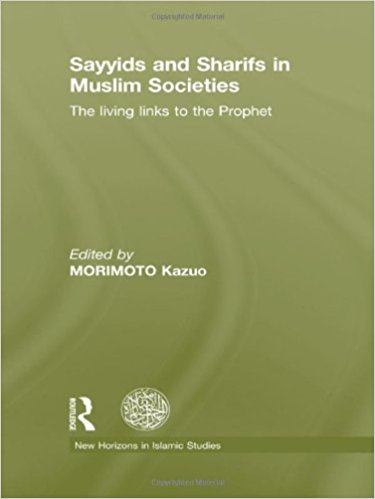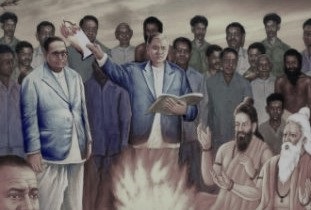Morimoto Kazuo
The world today is home to a great number of putative lineal descendants—and collateral relatives—of Muḥammad, the Prophet of Islam. Let us begin by sharing three recent episodes involving some of these kinsfolk of the Prophet.

Episode I: The film Close-Up (1990) by the renowned Iranian film director Abbas Kiarostami is an intricate cross between documentary and fiction, featuring a man apprehended for falsely presenting himself as Mohsen Makhmalbaf, a leading figure of Iranian cinema. The film re-enacts the interaction between the cinema-loving “conman” and his “victims,” the Āhankhāh family, as well as the trial of the case before a judge. Just as the trial is approaching its conclusion, an interesting incident takes place in the film. The defendant’s mother, clad in a black chador, suddenly steps forward and begins to plead with the judge that he should consider the prophetic descent of her son when handing out his sentence. It is true that this incident may not have taken place in reality. However, Kiarostami must certainly have thought that the scene would not appear unrealistic to his audience.
Episode II: Three days after Saddam Hussain was captured by the American troops in a burrow near Takrit, the “Syndic of Sharīfs” (Naqīb al-Ashrāf) of Iraq, named al-Sharīf al-Arajī, held a press conference. The naqīb announced that the investigation by the “Committee of Genealogies” (Lajnat al-Ansāb) confirmed that the prophetic descent claimed by the deposed president was utterly false. Saddam, he said, had forced genealogists to approve and sign his baseless genealogy. Further, the naqīb stated, Saddam had had a plan to establish the “Niqābat al-Ashrāf” (Syndicate of Sharīfs) and to become the naqīb himself; a plan that was thwarted by the passive resistance of the sharīfs themselves. Al-Sharīf al-Arajī was representing the new niqāba that was established after the collapse of Saddam’s regime, and which held its first meeting two days earlier with the theme, “For the Construction of New Iraq.”1
Episode III: In March 2010, a new action planned by the Saudi lawyer Faisal Yamani attracted the attention of the press. After getting the Danish newspaper Politiken to apologize for having offended Muslims by reprinting the well-known cartoons featuring the Prophet, he sent a “pre-action” letter to the ten other newspapers that had refused to apologize, and announced that he was planning to file a libel case against them with a London court. Yamani had been representing eight associations of the Prophet’s descendants from eight countries (Egypt, Libya, Qatar, Jordan, Saudi Arabia, Lebanon, Palestine and Australia) through these processes. Yamani was seeking to sue the newspapers on the ground that the reprinting of the cartoons amounted to defamation against the approximately 95,000 direct descendants of the Prophet that he was representing.2
As shown by these episodes, the Prophet’s kinsfolk, who are most frequently called by the honorific titles “sayyid” (pl. sāda, sādāt) or “sharīf” (pl. ashrāf, shurafā), have formed and still form a distinct social category in many Muslim societies. Their lineage may be adduced when an exceptional legal treatment is sought for them. It also constitutes symbolic capital to which a political leader seeking to enhance general perception of his or her qualifications may resort. Moreover, these people, in a good number of cases, possess enough cohesion to form organizations beyond their immediate families in order to promote their shared interests. Reliable statistics showing the number of the Prophet’s kinsfolk, spread all through the Muslim world and far beyond it, are not available. Even a conservative estimate, however, would suggest that the number of kinsfolk is in the tens of millions3.
The idea that the Prophet’s kinsfolk must be differentiated from the rest of the population and be given special treatment in one way or another has been shared by many, if not most, interpretations of Islam. It might appear quite natural to many readers when, for example, the Twelver Shiite scholar al-Shaykh al-Ṣadūq Ibn Bābūyah (d. 381/991) writes:
Our belief concerning the Alids [the descendants of the Prophet’s paternal cousin Alī b. Abī Ṭālib, who form the core of the Prophet’s kinsfolk] is that they are the Family of the Apostle of God (Āl Rasūl Allāh) and that loving them is obligatory (mawaddatuhum wājiba).4
Those readers may point out (somewhat rhetorically) that Shiites, after all, consider the leadership of the Umma (Muslim community) to be the birthright of the Prophet’s family. What then is the opinion of the Ḥanbalite scholar Ibn Taymiyya (d. 728/1328) in his Minhāj al-sunna al-nabawiyya, a refutation against nothing other than Twelver Shiism? This paragon of the traditionalist Sunnism also writes:
There is no doubt in that Muḥammad’s Family (Āl Muḥammad) has a right on the Umma that no other people share with them and that they are entitled to an added love and affection to which no other branches of the Quraysh are entitled.5
Certainly, the opinions of various Muslim religious scholars, including al-Ṣadūq and Ibn Taymiyya, can be markedly different when it comes to more concrete questions, such as who exactly constitute the Prophet’s kinsfolk, what the special treatments are that they are entitled to, or why they must be treated differently from the rest of the people. However, the base line that the Umma considers the Prophet’s kinsfolk to constitute a special category within the community and that a particular respect or regard should be offered to them has evidently been shared rather widely by various interpretations of Islam through the centuries.
[Morimoto Kazuo is an Associate Professor of Islamic and Iranian History at the Institute for Advanced Studies on Asia, University of Tokyo. The above extract is from Morimoto Kazuo (Ed.). (2012). Sayyids and Sharifs in Muslim Societies: The Living Links to the Prophet. London and New York: Routledge.]
~
Notes
1. “‘Niqābat al-ashrāf ‘ fī al-Irāq tulinu ibṭāl nasab al-raīs al-makhlū,” al-Sharq al-awsaṭ 9151 (24 Shawwāl1424/18December2003).www.aawsat.com/details.asp?section=1&article=208227&issueno=9151 (accessed 19 April 2011).
2. Richard Kerbaj, “Islamic Cartoon Row is Latest Case of Libel Tourism,” The Sunday Times, 21 March 2010. www.timesonline.co.uk/tol/news/uk/article7069734.ece (accessed 19 April 2011); “al-Muḥāmī Fayṣal al-Yamānī yatazimu mulāḥaqat 15 ṣaḥīfa Danmārkiyya nasharat al-rusūm al-musīa li-l-Rasūl,” najran9.com, 1 March 2010. www.najran9.com/news-action-show-id-6978.htm (accessed 19 April 2011); Lars Eriksen, “Danish Newspaper Apologises in Muhammad Cartoons Row,” guardian.co.uk, 26 February 2010. www.guardian. co.uk/world/2010/feb/26/danish-cartoons-muhammad-politiken-apology (accessed 19 April 2011). Yamani’s plan, however, has not been actualized as of July 2011. I thank Solicitor Mark Stephens for this update.
3. Ibrāhīm al-Zanjānī al-Mūsawī, in his Nihāyat al-falsafa al-Islāmiyya (Beirut: Mu———————-assasat al-Balāgh, 1407/1987), 109–110, presents his estimate of about thirty million direct descendants (the Ḥasanids and the Ḥusaynids). It is also reported that an estimate commissioned by Abdülhamid II (r. 1293–1327/1876–1909) gave the result of nineteen million direct descendants (al-dhurriyya al-nabawiyya) (Jafar al-Shaykh Bāqir Āl Maḥbūbah, Māḍī al-Najaf wa-ḥāḍiruhā, 3 vols, 2nd ed. [Beirut: Dār al-Aḍwā——————-, 1406/1986], I: 283, n. 1, citing al-Murshid, year one). Note also the remark, albeit not undisputed, in 2007 by the then naqīb al-ashrāf of Egypt that the ashrāf in that country were “close to five to six millions.” Egypt Today, June 2007. www.egypttoday.com/article.aspx?ArticleID=7407 (accessed 10 June 2009).
4. Al-Ṣadūq, al-Itiqādāt fī al-dīn al-Imāmiyya, ed. by Ghulām-Riḍā al-Māzandarānī (Qum: Editor, 1412/1992), 85. Cf. Ash-Shaykh aṣ-Ṣadūq, A Shīite Creed, trans. by A. A. Fyzee, rev. ed. 1982, 3rd ed. (Tehran: World Organization for Islamic Services, 1999), 99.
5. Ibn Taymiyya, Minhāj al-sunna al-nabawiyya, ed. by Muḥammad Rashād Sālim, 9 vols ([Riyadh]: Jāmiat al-Imām Muḥammad b. Saūd al-Islāmiyya, 1406/1986), IV:599.
~~~









